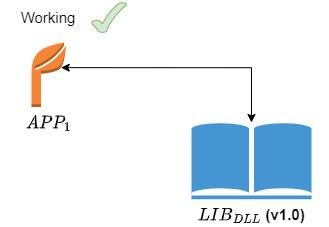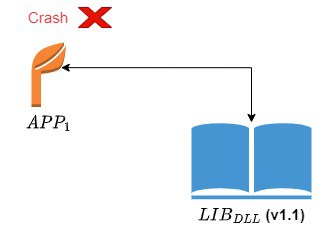1. 简介
在本篇文章中,我们将深入探讨经典的 DLL Hell 问题,以及其常见解决方案。这个问题曾经是 Windows 平台开发中的一大痛点,尤其在多个应用程序共享动态链接库(DLL)时极易引发兼容性问题。
如果你在开发或维护一个 Windows 应用程序时遇到过莫名其妙的崩溃或功能异常,很可能就是 DLL Hell 在作祟。我们不仅会解释它的成因,还会介绍现代系统中如何规避这一问题。
2. 什么是 DLL Hell 问题
DLL Hell 是指一个应用程序在运行时加载的 DLL 与它编译时所依赖的版本不一致,从而导致运行失败的现象。
动态链接库(DLL)是 Windows 平台上实现代码复用和资源共享的重要机制。然而,当多个应用程序共享同一个 DLL 时,如果其中一个程序更新了该 DLL(例如函数签名变更、接口删除等),而其他程序仍试图调用旧版本的接口,就可能触发运行时错误,如未解析符号、访问非法地址等。
示例场景
假设我们有一个应用程序 App1,它依赖于一个名为 Lib_DLL 的 DLL,版本为 1.0:

此时系统运行正常。但如果我们更新了 Lib_DLL 到 1.1 版本,并修改了部分函数接口,而 App1 仍尝试调用旧接口:

此时程序就会在运行时崩溃。
根本原因
DLL Hell 的核心在于:DLL 更新后,没有机制能自动判断其与旧程序的兼容性。即使是微小的改动,也可能导致已有程序无法正常运行。
3. Windows 平台的 DLL Hell 问题
DLL Hell 问题在 Windows 系统中尤为突出,因为很多应用程序会将共享 DLL 安装到全局路径(如 System32)下。当多个程序依赖不同版本的同一个 DLL 时,系统无法自动识别并加载正确的版本。
不过,随着 .NET Framework 的引入,这一问题在 .NET 系统中得到了很大程度的缓解。.NET 的加载器能够通过解析 DLL 的版本号,并从注册表中查找对应的程序集(Assembly),从而实现版本控制。
4. Linux 平台的 DLL Hell 问题
Linux 中不存在类似 Windows 的 DLL Hell 问题,主要原因在于其依赖管理机制更加完善:
- 包管理器(如 apt、yum)会自动处理依赖关系,确保安装的库版本与应用程序兼容。
- 共享库(Shared Library)通常以独立包形式存在,并带有明确的版本号。
- 应用程序在编译时声明其依赖的库名和版本,例如:“X 依赖于 Y(版本 >= 6.0)”。
因此,Linux 系统能够自动选择合适的库版本,避免了 DLL Hell。
5. 解决方案
解决 DLL Hell 问题的关键在于如何管理 DLL 的版本与依赖关系。以下是两种主流方案:
5.1 使用 Side-by-Side(并行)版本控制(适用于 .NET)
Side-by-Side(SxS)机制允许系统同时安装多个版本的同一个 DLL,并根据应用程序的配置加载正确的版本。
在 .NET 中,每个 DLL(称为 Assembly)都有一个标准的版本号格式:W.X.Y.Z:
W:主版本号(Major)X:次版本号(Minor)Y:修订号(Build)Z:发布号(Revision)
这些 DLL 会被统一存放在一个称为 GAC(Global Assembly Cache) 的全局缓存中。GAC 中每个 Assembly 条目包含四个关键信息:
- 程序集名称
- 版本号
- 区域信息(如 "en" 或 "zh-CN")
- 公钥令牌(Public Key Token)
示例场景
假设两个应用程序 App1 和 App2 都依赖于 dll_shared,版本为 1.0.0.0。现在我们更新了这个 DLL 到 2.0.0.0,并修改了部分接口:
App1更新为使用 2.0.0.0App2仍使用 1.0.0.0
由于 GAC 中同时存在两个版本,系统会根据程序配置加载正确的 DLL,从而避免冲突。
⚠️ 注意:Side-by-Side 只适用于没有共享依赖的 DLL。如果有多个 DLL 之间存在版本依赖,管理会变得复杂。
5.2 让应用程序自带私有 DLL(适用于独立部署)
另一种解决方案是让应用程序自带其所需的 DLL 文件,而不是依赖全局安装的版本。
这种方式的优点是:
✅ 避免 DLL 冲突
✅ 部署简单,无需依赖系统环境
✅ 更容易控制 DLL 版本
但缺点也很明显:
❌ 安全风险:私有 DLL 可能被恶意篡改
❌ 资源浪费:多个程序各自保存一份相同 DLL
❌ 维护成本:每次更新都要同步所有私有 DLL
因此,这种方案适合对部署独立性要求高、但对安全性和资源占用不敏感的场景。
6. 总结
DLL Hell 是 Windows 开发中一个经典问题,源于动态链接库版本不一致导致的运行时错误。虽然 .NET 引入的 Side-by-Side 机制在很大程度上缓解了这一问题,但在某些复杂场景下仍需谨慎处理。
以下是关键要点总结:
| 方案 | 优点 | 缺点 |
|---|---|---|
| Side-by-Side(SxS) | 多版本共存,集中管理 | 配置复杂,不适用于有共享依赖的 DLL |
| 私有 DLL 部署 | 部署简单,隔离性好 | 安全风险高,资源浪费严重 |
✅ 推荐做法:在 .NET 环境中优先使用 SxS;在独立部署场景中可考虑私有 DLL,但需定期更新以确保安全。
如你所见,DLL Hell 虽然听起来像一个“历史遗留问题”,但在实际开发中仍然值得关注。希望这篇文章能帮助你在开发过程中避免踩坑,写出更健壮的 Windows 应用程序。